|
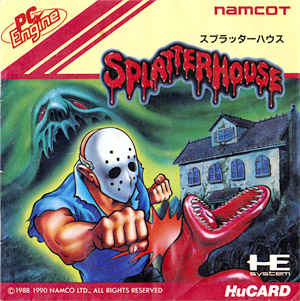
|

|
|
スプラッターハウス
©1988 1990 Namco Ltd.
Release : 1990-04-03 (¥6800)
HuCard (4 Mbits) NC90002
Action / Platform game
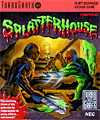

|
Released in America as
SPLATTERHOUSE
( TGX040041 )
|
|
Splatterhouse is a side-scrolling horror themed action game developed by Namco,
and conversion of the arcade game of the same name originally released in 1988. It stars two young
scientists interested in paranormal phenomenons, Rick Taylor and Jennifer Wills, who
one day decide to investigate a strange old mansion that that has been known to harbor many terrifying
secrets. The gloomy house, named the 'Splatterhouse' by the locals, is owned by Dr West,
a renowned scientist rumored to conduct bizarre and gruesome experiments. One night, as they arrive at
the mysterious mansion, a storm starts raging and they are forced to take shelter inside the dark place.
They both come under attack and Rick falls unconscious. When he regains consciousness, he
discovers that Jennifer is gone, and that a creepy mask with supernatural powers
(the "Hell Mask") now covers his face. His body has also mutated into that of a repulsive,
and yet tremendously powerful, burly creature. Rick must now explore the mansion and find his
beloved Jennifer - but hordes of murky deadmen, impaled zombies, flesh eating worms and other
nightmarish and grotesque creatures are now on the loose everywhere. Rick can punch with his
bear fists and kick (low, jump kicks and slide kicks), and can also pick up weapons scattered throughout
the game, such as a planks of wood (the 'two by four'), spears, a lethal meat cleaver or a shotgun.
More than just enemies, the game
also throws disguised booby traps and ominous obstacles at the player, such as sharp blades, spikes,
bottomless pits and other lethal dangers. Splatterhouse consists of seven levels, and some stages
even branch out (through holes in the ground or ladders) and allow the player to take alternate routes.
|
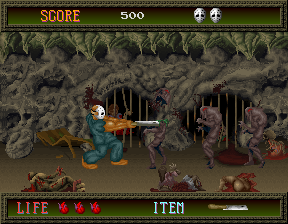 The arcade game Splatterhouse was originally released in 1988 (picture on the right). Although the game was
a beat'em up at heart, its gory theme was really what set it apart from other games at the time.
The game was later converted to the PC Engine (1990), FM Towns (1992), PC (2003)
and even a LCD game was released in 1988. As a side note, the first Splatterhouse that Namco
developed for home consoles was not a straight conversion of the original arcade game, but rather a
parody - the cute Splatterhouse Wanpaku Graffiti was released for the Famicom system in
1989, and was most certainly designed to appeal to a younger audience. Two sequels to the original
arcade game were later exclusively released for the Sega Megadrive - Splatterhouse Part 2 (1992)
and Splatterhouse Part 3 (1993). These two megadrive games are interesting, in particular, because they
reveal the evolution of the demonic Hell Mask (also known as the "Terror Mask" in the west). It looks like there
has always been fears regarding copyright issues between Splatterhouse and Friday the 13th, and
although first versions of the Hell Mask definitively look like Jason Voorhees's classic hockey
mask, Japanese early releases didn't change its design. This wasn't the case for western releases, where the
mask was edited to look more like a deformed human skull (Splatterhouse 2). This design was later used
in Splatterhouse 3, both for the Japanese and Western releases. Finally, the franchise
then laid dormant for several years - the latest installment was the awfully average and messy beat'm up
Splatterhouse released for the Playstation 3 in 2010, which desperately attempted to revive
the excellent series, but miserably failed at it.
The arcade game Splatterhouse was originally released in 1988 (picture on the right). Although the game was
a beat'em up at heart, its gory theme was really what set it apart from other games at the time.
The game was later converted to the PC Engine (1990), FM Towns (1992), PC (2003)
and even a LCD game was released in 1988. As a side note, the first Splatterhouse that Namco
developed for home consoles was not a straight conversion of the original arcade game, but rather a
parody - the cute Splatterhouse Wanpaku Graffiti was released for the Famicom system in
1989, and was most certainly designed to appeal to a younger audience. Two sequels to the original
arcade game were later exclusively released for the Sega Megadrive - Splatterhouse Part 2 (1992)
and Splatterhouse Part 3 (1993). These two megadrive games are interesting, in particular, because they
reveal the evolution of the demonic Hell Mask (also known as the "Terror Mask" in the west). It looks like there
has always been fears regarding copyright issues between Splatterhouse and Friday the 13th, and
although first versions of the Hell Mask definitively look like Jason Voorhees's classic hockey
mask, Japanese early releases didn't change its design. This wasn't the case for western releases, where the
mask was edited to look more like a deformed human skull (Splatterhouse 2). This design was later used
in Splatterhouse 3, both for the Japanese and Western releases. Finally, the franchise
then laid dormant for several years - the latest installment was the awfully average and messy beat'm up
Splatterhouse released for the Playstation 3 in 2010, which desperately attempted to revive
the excellent series, but miserably failed at it.
|
There are some differences between the original arcade game and this PC Engine conversion.
First of all, the introduction sequence was dramatically reduced and only features the exterior view of
the mansion (we don't see Jennifer and Kirk running through the rain, or the Hell Mark
taking over the hero's body and soul). The in-between level screens are also different - although the arcade
game shows a picture from the coming stage, the PC Engine port shows one of the creature the player
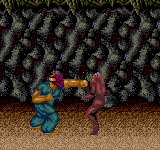 will eventually fight there. Interestingly, the gore factor was also toned down a little - for instance, the
first level features prison cells in the background and mutilated human bodies which were completely removed
from the PC Engine port. Weapons have also be shuffled around, for instance although Rick first picks
a meat cleaver in the arcade version, the PC Engine port features a wooden plank, and the cleaver only
appears once in the chapel stage (and was curiously turned into a Golden Cleaver). Finally, the
American Turbografx-16 was edited further and in different ways - the most notable is the Hell mask,
which was changed from the original white to a darker red (probably to avoid copyright issues with the Friday
the 13th franchise, picture on the left). Because of this change, the mirror-image enemies found in level
Level 4 wear blue masks instead of grey masks. Other TG16 changes include material
containing any religious references... In stage 4, the antichrist boss
(the inverted cross) was replaced by a blue grinning demon head, and the altar at the
end of the same level was completely removed (only four 'floating' candles are now visible). Finally,
the cross planted in the ground at the end of stage 7 was replaced by a tombstone. As a side note,
the Turbografx-16 version also had a parental warning message printed on the game's
cover which said "The horrifying theme of this game may be inappropriate for
young children... and cowards." - it is hard to tell if this was a serious message (I believe
game ratings only appear in the mid-1990s) or just a passing joke...
will eventually fight there. Interestingly, the gore factor was also toned down a little - for instance, the
first level features prison cells in the background and mutilated human bodies which were completely removed
from the PC Engine port. Weapons have also be shuffled around, for instance although Rick first picks
a meat cleaver in the arcade version, the PC Engine port features a wooden plank, and the cleaver only
appears once in the chapel stage (and was curiously turned into a Golden Cleaver). Finally, the
American Turbografx-16 was edited further and in different ways - the most notable is the Hell mask,
which was changed from the original white to a darker red (probably to avoid copyright issues with the Friday
the 13th franchise, picture on the left). Because of this change, the mirror-image enemies found in level
Level 4 wear blue masks instead of grey masks. Other TG16 changes include material
containing any religious references... In stage 4, the antichrist boss
(the inverted cross) was replaced by a blue grinning demon head, and the altar at the
end of the same level was completely removed (only four 'floating' candles are now visible). Finally,
the cross planted in the ground at the end of stage 7 was replaced by a tombstone. As a side note,
the Turbografx-16 version also had a parental warning message printed on the game's
cover which said "The horrifying theme of this game may be inappropriate for
young children... and cowards." - it is hard to tell if this was a serious message (I believe
game ratings only appear in the mid-1990s) or just a passing joke...
|
Teaser text from the American version:
Alone on a stormy night... enter, if you dare, the unspeakable
horror of SPLATTERHOUSE! Hideous ghouls and demented demons
leap from every corner in a relentless nightmare of terror. Who's
that with a saw? Look out for that axe! Just don't lose your head,
as shock after gruesome shock assaults your senses. Your only
hope... unleash the monster within yourself and fight back in the
grisly mayhem of SPLATTERHOUSE!
|
Game Staff (Copied from the end credits) :
|
SPLATTER HOUSE
STAFF
Director
Y. Asada
Mr. Yokoyama
Producer
Kazuu
Papaya Payapaya
| |
Editor
Kirifune
Sound Program
T. Kobayashi
Sound
Joshua
Original Music
Chopin
Kawagen
|
|
Graphic Designed
Y. Sakakibara
Art
Akumakun
Original Art
M. Ishida
Visual Effect
T. Oda
Special Designed
Daihadan13
|
|
Title Designed
Spanky Usukura
Special Artist
Tenkomoriya~N
Special Thanks
Bolero
1988 1990
NAMCO LTD.
|
|
O
M
A
K
E
|
|
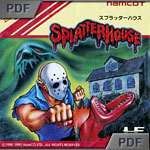
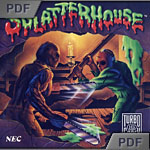
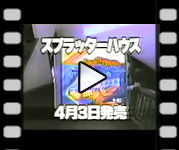
|
|
|
Click on picture to enlarge |
S
E
C
R
E
T
S
|
|
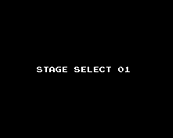 Stage and sound select screen:
Stage and sound select screen:
On the title screen, press Run to start a new game. Then, when the
screen with the mansion in the rain appears, press Select three
times, then hold down and left, and press
I and II at the same time. The Stage select screen
will appear (picture on the right). If you press Select on the
level select screen, the menu will change to a sound test. Press Select
again to switch back to the stage menu.
|
|
|
|
LK

|
|
Add your Pov here !
|
P
O
V
s
|
|
The horror and macabre theme, gory effects and grotesque enemies all contributed to
Splatterhouse's success in the late 1980s. Although the gore was slightly turned down,
this PC Engine port really delivers the goods! What I like the most about
Splatterhouse is its gross-out comedy (unlike the gratuitous and extreme violence
that can be found in today's games) that reminds me of the classic horror movies from the 1980s,
such as Friday the 13th or Nightmare on Elm Street. There is a palpable sense of
smugness when you swing that wooden plank for the first time, and splatter zombies against a wall.
Although levels tend to look alike, enemy designs are rather unique and creative, and some are
particularly vile and disturbing. I have only one gripe about the game - Kirk can be really
stiff to control, and the game becomes a real challenge when the screen gets cluttered with enemies.
But, all in all, this PC Engine port is an excellent conversion and is overall really
faithful to the arcade. I feel that this version definitively helped drive Splatterhouse
popularity outside of Japan (the coin-op was a very rare occurrence in the west).
|
|
|
|